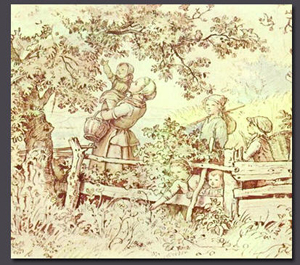Home page
» PAINTING ART
» Graphics(Drawing)
» On graphics
On graphics In XIX century only lines or white and black lines made the basis of graphics. Later, this type of art was further improved. Contour lines, stripes, spots, as well as the whiteness of main graphic material were main means of artistic drawing.
For work techniques the graphic art are divided into two parts - painting and print graphics. The most ancient and traditional art forms are painting. The picture is drawn by pencil on white paper, and sometimes on the cloth. There paintings are made only in one copy. As some works are rich in color, it has the proximity with painting: these are paintings drawn by water paints (watercolor, gouache, tempera) or pastels (colored pencil). By the method of graphic works, t is possible to create images in portraits landscapes, etc genres.
Another type of graphics - printed graphic differs from painting because it is possible to get many copies from them on same quality, unlike painting. It includes paintings carved on metal, wood, stone, and magnesium. In print graphics, depending on the graphic material of board the different techniques were formed. Engraving made on metal, namely copper, and then drawn with a needle by the method of compression is called etching. Graphic on stone is called lithography (lito in Greek, means stone), and graphics on wood is called xylography (xylo – in Greek means tree) is called. Engraving, which was formed comparatively later, i.e. linocut in the paintings on linoleum.
History of Graphic in Azerbaijan
The first examples of graphic art can be found at Gobustan rock paintings, works created by painters of Tabriz miniature art school and in graphic works of painters. However, the art design of classic literary works, manuscripts and religious books show that the graphic design has an ancient history in Azerbaijan.
The establishment and development of satiric graphic is connected with the activity of the Molla Nasreddin journal. A skilful cartoonist Azim Azimzade (1880-1943) had an exceptional role in development of Azerbaijan Soviet graphic art. He worked in different genres of graphic images in different ranges like posters, cartoons, stage design, costume sketches, etc.
The most perfect work in the field of graphic books created by A. Azimzade is illustrations to M.A.Sabir’s Hophopname.
During 30-es Gazanfar Khaligov, Ismail Akhundov, Kazim Kazimzade, A. Mammadov and others worked in the field of graphic art. They have created political placards on urgent issues by drawing illustrations to books of Azerbaijani and foreign country writers.
During 50-es searches in the fields of subject, title, genre, colors of artistic style had occupied a leading role in the development of graphic art. Serial of works were created from easel graphic types. Linocut and painting series created by Maral Rahmanzade, devoted to labor and welfare issues In our Caspian Sea (1953-60), My sisters (1965-82), colors of auto linocuts Azerbaijan is an oil country (1947) differ with variety of images, national peculiarities. Linocuts of Alakbar Rzaquliyev Old Baku, Carpets, R. Babayev’s Gobustan, Khinaliq are characterized by expression of perfectness of folk life.
During 60-70-es it was the beginning of a new stage in the easel graphics. It is found in works of S. Bahlulzadeh, N. Akhundov, Y. Huseynov, N. Babayev, R. Huseynov, A. Alasgarov and others.
|
